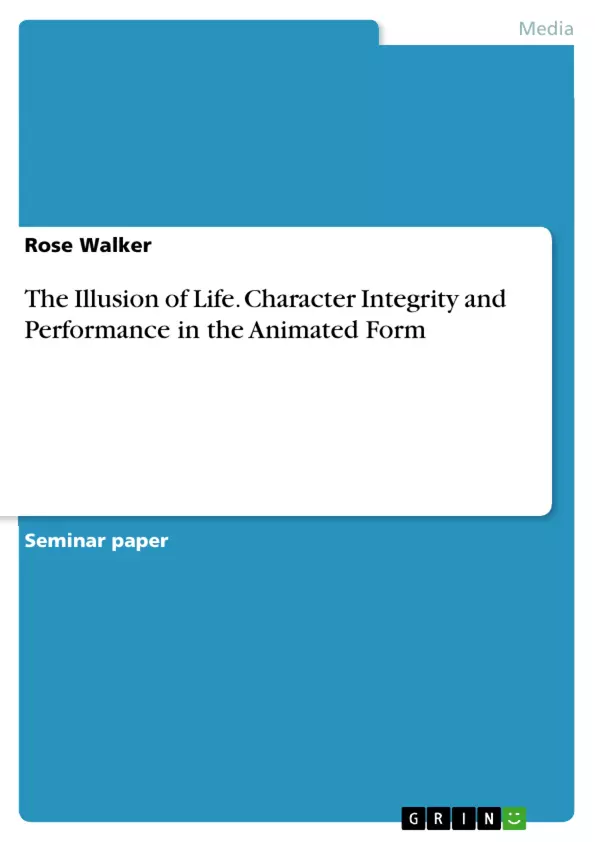The thesis investigates the reasons and motivations behind our emotional and affective responses to the animated character. In a form suffused with a self-conscious display of artifice and fabrication, there is a paradox of how we can respond to the animated figure in much the same way as a live actor and real life individual. The stop-motion form in particular provides doubt for engagement to occur, yet even with new and improving advancements of technology, this self-conscious, sometimes rough form holds a firm place in cinematic culture today.
To fully understand the justifications and limitations of our engagement, I appeal to the motivations and skills of the animator in designing a character and making it a ‘performer.’ The study has revealed the goal of an animator is for believability more so than realism; ensuring every nuance of the character encourages an active spectator who is willing to suspend their disbelief for the duration of the film in order to enjoy and engage with it.
Table of Contents
- Acknowledgements
- Table of Contents
- List of Illustrations
- Abstract
- Introduction
- Literature Review
- The Significance and Appeal of Animation
- Stop-Motion Animation
- Character Design and Construction
- Character Performance
- Performance Through Movement
- Performance Through Voice
- Performance from Pantomime Characters
- Performance Through Anthropomorphism
- Conclusion
- Bibliography
- Filmography
- Appendixes.
Objectives and Key Themes
This research explores the illusion of life in animated characters, focusing on the concept of character integrity and its relationship to performance. The study delves into the methods used in animation to convey emotion, personality, and character through movement, voice, and other visual and auditory cues. The overarching aim is to understand how animators achieve a sense of believability and authenticity in animated characters, making them resonate with audiences.
- Character Integrity in Animation
- Performance Techniques in Animated Film
- The Role of Movement and Voice in Character Development
- The Illusion of Life and Audience Engagement
- The Impact of Animation on Storytelling and Emotional Connection
Chapter Summaries
- Introduction: This chapter provides an overview of the research topic and its significance. It outlines the key themes, objectives, and methodology of the study, framing the discussion within the broader context of animated film.
- Literature Review: This chapter explores existing literature and scholarship relevant to the study of character integrity and performance in animation. It reviews key theories and concepts, including discussions on the history of animation, character design, and the psychology of audience engagement.
- The Significance and Appeal of Animation: This chapter examines the enduring appeal of animation as a storytelling medium. It explores the unique qualities of animation and its ability to transcend cultural boundaries, engaging audiences of all ages. The chapter also discusses the evolution of animation techniques and their impact on narrative and visual storytelling.
- Stop-Motion Animation: This chapter focuses on the specific techniques and challenges of stop-motion animation. It examines the process of creating and animating characters using physical objects, highlighting the unique qualities of this form of animation and its contribution to the illusion of life.
- Character Design and Construction: This chapter delves into the principles of character design and construction in animation. It explores how animators develop characters with distinct personalities and visual features, focusing on the interplay between visual design and character performance.
- Character Performance: This chapter examines the concept of character performance in animation, focusing on the key elements that contribute to the creation of believable and engaging characters. It explores the use of movement, voice, and other performance techniques to convey emotion, personality, and character.
- Performance Through Movement: This chapter explores the role of movement in animated character performance. It examines the principles of animation, such as squash and stretch, timing, and anticipation, and their impact on conveying emotion and personality through physical actions.
- Performance Through Voice: This chapter focuses on the importance of voice acting in animated character performance. It discusses the interplay between voice and visual animation, examining how vocal delivery, tone, and pacing contribute to character development and audience engagement.
- Performance from Pantomime Characters: This chapter analyzes the unique challenges and possibilities of animating pantomime characters. It explores the role of facial expressions, body language, and other visual cues in conveying emotion and personality without the use of dialogue.
- Performance Through Anthropomorphism: This chapter examines the art of animating anthropomorphic characters, those with human-like qualities and abilities. It explores the techniques used to create believable and engaging characters with animal-like characteristics, focusing on the intersection of animal behavior and human emotions.
Keywords
Character integrity, performance, animation, stop-motion, character design, movement, voice, pantomime, anthropomorphism, illusion of life, audience engagement, emotional connection, storytelling, visual storytelling, believability, authenticity, animated film, animated characters.
- Arbeit zitieren
- Rose Walker (Autor:in), 2017, The Illusion of Life. Character Integrity and Performance in the Animated Form, München, GRIN Verlag, https://www.grin.com/document/515158



